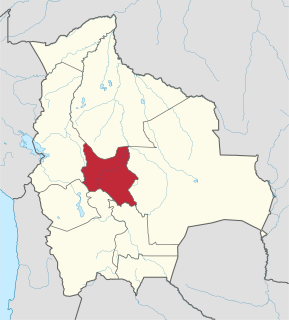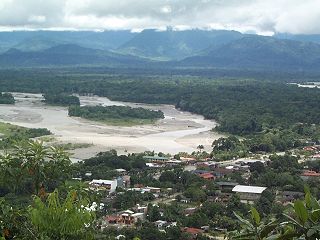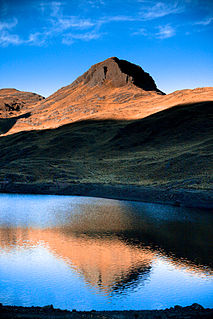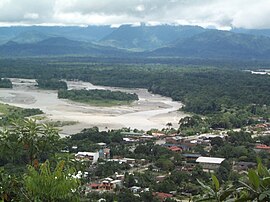
Cochabamba, from Quechua qucha or qhucha, meaning "lake", pampa meaning "plain", is one of the nine departments of Bolivia. It is known to be the "granary" of the country because of its variety of agricultural products from its geographical position. It has an area of 55,631 km2. Its population in the 2012 census was 1,758,143. Its capital is the city of Cochabamba, known as the "City of Eternal Spring" and "The Garden City" because of its spring-like temperatures all year.

Chapare, also called The Chapare and is pronounced Cha-pa-reh, is a rural province in the northern region of Cochabamba Department in central Bolivia. The majority of the territory consists of valley rainforests that surround the area's main waterway, the Chapare River, which is also a tributary of the Amazon River. The provincial capital is Sacaba, 11 km east of Cochabamba. Its principal town is Villa Tunari, a popular tourist destination.

Comunidad Inti Wara Yassi (CIWY) is a Bolivian non-governmental organization dedicated to environmental education and the care of sick, mistreated and abandoned wildlife. It is the country's largest destination for confiscated wildlife and currently cares for around 500 animals, most of them rescued from the illegal wildlife trade.
Inti is the Incan sun god. Inti may also refer to:

Totora, Tutura or T'utura is a town in the Carrasco Province of the Cochabamba Department in Bolivia. It is the capital and most-populous place of the Totora Municipality. As of the 2012 census, the population is 1,925. The first settlers were Inca Indians. Totora was officially settled in 1876, and declared a town by the Government of Bolivia in 1894.

Isiboro Sécure National Park and Indigenous Territory is a protected area and Native Community Land in Bolivia situated between the north of the Cochabamba Department and the south of the Beni Department. It protects part of the Bolivian Yungas ecoregion. The indigenous people living within the park belong to the Tsimané, Yuracaré, and Mojeño-Trinitario peoples. The southern portion of the park has been colonized by agricultural settlers, primarily coca farmers, since the 1970s. The Bolivian government estimates that 10% of the park has been deforested by their presence.

Entre Ríos is a small town in the Cochabamba Department of the South American Republic of Bolivia.

Pocona is a location in the Cochabamba Department in central Bolivia. It is the seat of the Pocona Municipality, the third municipal section of the Carrasco Province. At the time of census 2001 it had a population of 244.

Quillacollo Municipality is the first municipal section of the Quillacollo Province in the Cochabamba Department, Bolivia. Its capital is Quillacollo. At the time of census 2001 the municipality had 104,206 inhabitants.

Chimoré Municipality is the fourth municipal section of the Carrasco Province in the Cochabamba Department, Bolivia. Its seat is Chimoré.

Totora Municipality is the first municipal section of the Carrasco Province in the Cochabamba Department, Bolivia. Its seat is Totora.

Villa Rivero Municipality or Muela Municipality is the second municipal section of the Punata Province in the Cochabamba Department in Bolivia. Its seat is Villa Rivero.

Villa Tunari Municipality is the third municipal section of the Chapare Province in the Cochabamba Department, Bolivia. Its seat is Villa Tunari. The population grew from 52,886 to 71,146 during 2001 to 2012 according to the census. Only 8,692 of the population are urban and are concentrated in the small towns of Villa Tunari (3.213), Eterazama (3,359) and Villa 14 the Septiembre (2,123). The municipality is famous for tourist especially the Villa Tunari town where the tourist industry is concentrated with infrastructure, and also because of the closeness of the Machia Park.

Vinto is a town in the Cochabamba Department in central Bolivia. It is the seat of the Vinto Municipality, the fourth municipal section of the Quillacollo Province.

Entre Ríos Municipality is the sixth municipal section of the Carrasco Province in the Cochabamba Department in central Bolivia. Its seat Entre Ríos had 3,796 inhabitants at the time of census 2001.

Warawara, often spelled Wara Wara, is a lake in the Tunari National Park in Bolivia. It is located in the Cochabamba Department, Chapare Province, Sacaba Municipality. Warawara lies north east of the city Cochabamba and north of Alalay Lake. The lake is situated 4,105 metres (13,468 ft) high. It is 0.8 km long and 0.5 km at its widest point.

San Ignacio del Sara is a town in the Santa Cruz department in the lowlands of the South American Andes state of Bolivia.

Q'ara Apachita is a 4,639 m (15,220 ft) mountain in the Bolivian Andes. It is located in the Cochabamba Department, Chapare Province, Villa Tunari Municipality.

Uqi Salli Punta is a 4,840-metre-high (15,880 ft) mountain in the Bolivian Andes. It is located in the Cochabamba Department, on the border of the Chapare Province, Villa Tunari Municipality, and the Quillacollo Province, Quillacollo Municipality.














